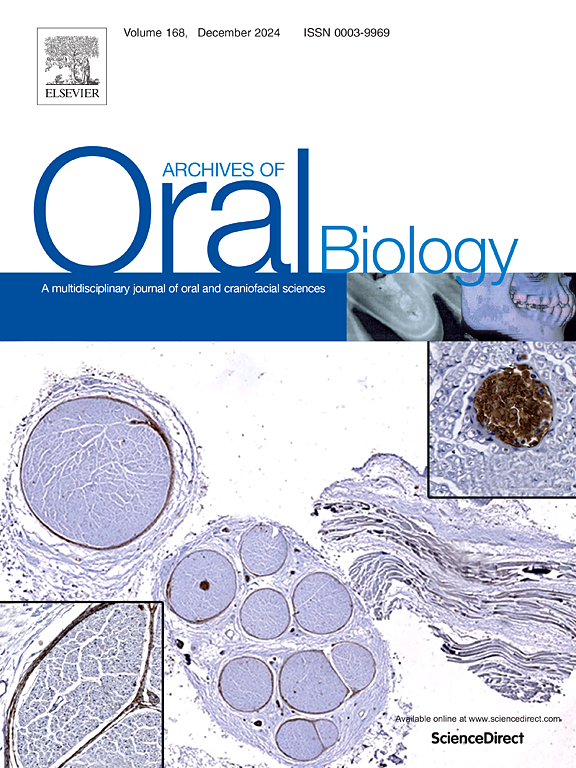脱落酸改善认知功能障碍,但没有面部异常痛,在一个雄性大鼠硝酸甘油偏头痛模型
IF 2.1
4区 医学
Q2 DENTISTRY, ORAL SURGERY & MEDICINE
引用次数: 0
摘要
脱落酸(ABA)存在于水果和蔬菜中,并在人体中产生,具有抗炎、抗氧化和促进认知的作用。评估ABA对大鼠偏头痛模型三叉神经痛觉过敏和认知行为的影响。设计雄性大鼠(n = 8只)随机分为5组(对照组、假手术组、脱落酸(ABA)组、硝化甘油(NTG)组和硝化甘油+ 脱落酸(NTG+ABA)组。通过4次注射NTG(5 mg/kg腹腔注射)诱导偏头痛。ABA(10 µg/大鼠脑室(i.c.v)) 4次,间隔24 小时。为了评估三叉神经痛觉过敏,采用von Frey、丙酮和充气试验。为了评估动物的运动和认知功能,进行了开阔场、高架迷宫(EPM)、悬尾(TST)、Morris水迷宫(MWM)和被动回避(PA)测试。总抗氧化能力水平(n = 5;TAC)也进行了监测。结果治疗组与对照组疼痛指数差异有统计学意义,但ABA对偏头痛动物的疼痛指数无显著影响。偏头痛组中接受aba治疗的动物表现出类似焦虑和抑郁的行为减少。此外,在MWM测试中,ABA动物表现出空间学习的改善,而记忆没有表现出改善。使用PA评估时,回避学习和记忆不受影响。在aba处理过的动物血清和三叉神经脊髓核中TAC均有增加。综上所述,ABA可减轻ntg诱导的认知损伤,抗氧化活性可能在ABA介导的认知损伤机制中发挥作用。本文章由计算机程序翻译,如有差异,请以英文原文为准。
Abscisic acid ameliorates cognitive dysfunctions, but not facial allodynia, in a male rat nitroglycerin migraine model
Objective
Abscisic acid (ABA), found in fruits and vegetables and produced in the human body, has anti-inflammatory, anti-oxidative, and pro-cognitive effects. The impact of ABA on trigeminal nerve hyperalgesia and cognitive behaviors in a rat migraine model was evaluated.
Design
Male rats (n = 8) were randomly distributed into 5 groups (Control, Sham, Abscisic acid (ABA), Nitroglycerin (NTG), and Nitroglycerin + Abscisic acid (NTG+ABA). Migraine was induced through 4 injections of NTG (5 mg/kg intraperitoneal (i.p.)). ABA (10 µg/rat intracerebroventricular (i.c.v)) was administered 4 times with an interval of 24 hours. To evaluate trigeminal nerve hyperalgesia, the von Frey, acetone, and air puff tests were used. To evaluate locomotor and cognitive function of the animals, the open field, elevated plus maze (EPM), tail suspension (TST), Morris water maze (MWM), and passive avoidance (PA) tests were administered. Total antioxidant capacity levels (n = 5; TAC) were also monitored.
Results
Significant differences were observed between the surgically treated groups and the control group, but no differences in pain indexes were found in migraine animals when ABA was present. ABA-treated animals among the migraine groups showed reductions in anxiety-like and depression-like behaviors. Additionally, in the MWM test, the ABA animals exhibited improved spatial learning, while their memory did not show improvement. Avoidance learning and memory were not affected when evaluated using the PA. Increases in TAC were seen in ABA-treated animals in both serum and the spinal trigeminal nucleus.
Conclusion
Taken together, ABA reduces NTG-induced cognitive impairments, and antioxidant activity could play a role in the underlying ABA-mediated mechanism.
求助全文
通过发布文献求助,成功后即可免费获取论文全文。
去求助
来源期刊

Archives of oral biology
医学-牙科与口腔外科
CiteScore
5.10
自引率
3.30%
发文量
177
审稿时长
26 days
期刊介绍:
Archives of Oral Biology is an international journal which aims to publish papers of the highest scientific quality in the oral and craniofacial sciences. The journal is particularly interested in research which advances knowledge in the mechanisms of craniofacial development and disease, including:
Cell and molecular biology
Molecular genetics
Immunology
Pathogenesis
Cellular microbiology
Embryology
Syndromology
Forensic dentistry
 求助内容:
求助内容: 应助结果提醒方式:
应助结果提醒方式:


